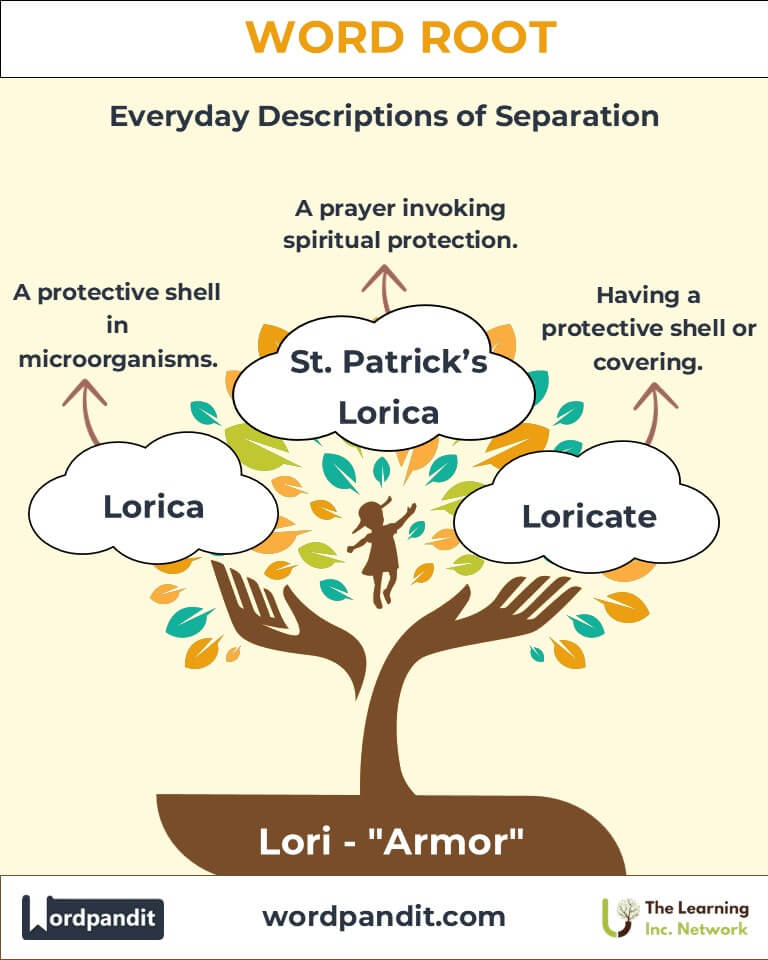Lori: The Armor Root That Shields Language and Science
Byline: Discover the fascinating world of the word root "lori," derived from the Latin word for "armor." This root forms the foundation of terms like lorica and loricate, enriching our vocabulary with concepts of protection and defense. Explore how "lori" connects ancient traditions, modern science, and the natural world.

Table of Contents
- Introduction: The Protective Power of "Lori"
- Etymology and Historical Journey
- Mnemonic: Unlocking the Power of "Lori"
- Common "Lori"-Related Terms
- "Lori" Through Time
- "Lori" in Specialized Fields
- Illustrative Story: "Lori" in Action
- Cultural Significance of the "Lori" Root
- The "Lori" Family Tree
- FAQs About the “Lori” Word Root
- Test Your Knowledge: “Lori” Word Root Quiz
- Conclusion: The Enduring Legacy of Kerat
Introduction: The Protective Power of "Lori"
When we think of armor, images of knights clad in shining metal come to mind. But the concept of armor goes beyond medieval battlefields. The word root "lori," meaning "armor," shields language and science alike, serving as the basis for terms that symbolize protection in various contexts. Derived from Latin, "lori" represents both physical and metaphorical defenses in nature, culture, and technology.

Etymology and Historical Journey
The root "lori" traces back to the Latin lorica, meaning "armor" or "protective covering." In Roman times, the lorica was a critical piece of a soldier’s equipment, offering physical protection during battles. Over time, this term transcended its literal meaning, becoming a metaphor for various protective structures, from religious symbolism to biological terminology.
In medieval Christianity, the lorica became a term for spiritual armor, such as prayer or hymns used to ward off evil. Meanwhile, in biology, "lori" evolved to describe protective shells or coverings in organisms.
Mnemonic: Unlocking the Power of "Lori"
To remember "lori," picture a knight donning a suit of shimmering armor, ready to defend against any threat. The armor shields the knight, much like the root "lori" fortifies words with meanings of protection.
Mnemonic Device: “Lori locks in protection, like armor for the body and soul.”
Common "Lori"-Related Terms
- Lorica (lor-i-ka):
- Definition: A protective shell or covering in biology.
- Example: "The diatom’s intricate lorica provides a sturdy defense against predators."
- Loricate (lor-i-kate):
- Definition: Having a protective shell or covered in armor.
- Example: "Certain protozoa are loricate, safeguarding their delicate structures with a hardened covering."
- Lorica Segmentata (lor-i-ka seg-men-ta-ta):
- Definition: A type of Roman body armor made of metal strips.
- Example: "The lorica segmentata was a hallmark of Roman military ingenuity."
- Loricifera (lor-i-sif-er-a):
- Definition: A phylum of marine animals known for their armored body coverings.
- Example: "The Loricifera thrive in extreme ocean depths, their armor-like lorica offering protection."
"Lori" Through Time
- Ancient Rome:
The lorica was a literal suit of armor, symbolizing strength and resilience.
- Medieval Europe:
The term expanded into spiritual realms, describing protective prayers like St. Patrick’s Lorica.
- Modern Biology:
Scientists adopted "lorica" to describe protective structures in microorganisms and marine life.
"Lori" in Specialized Fields
- Biology:
Loricate organisms include ciliates and diatoms with protective coverings.
Example: In aquatic ecosystems, loricate protists play vital roles in nutrient cycling.
- History and Archaeology:
The lorica segmentata remains an iconic artifact of Roman engineering and military strategy.
Example: Excavations often uncover fragments of lorica segmentata, shedding light on ancient warfare.
- Literature and Religion:
The term lorica in religious texts signifies spiritual protection.
Example: St. Patrick’s Lorica prayer invokes divine armor against evil forces.
Illustrative Story: "Lori" in Action
Deep beneath the ocean’s surface, a Loricifera named Lora navigated her dark, high-pressure world. Her lorica, a beautifully intricate shell, shielded her from predators and the harsh environment. One day, while exploring a hydrothermal vent, Lora discovered a microbe colony, teaching her that her armor was not just a defense—it also enabled her to brave new frontiers. Lora’s journey exemplifies the strength and adaptability embodied by the "lori" root.
Cultural Significance of the "Lori" Root
The protective essence of "lori" resonates in human culture. From the Roman legions’ reliance on physical armor to modern spiritual practices invoking divine protection, the concept of shielding oneself—physically, emotionally, or spiritually—remains universal. The lorica prayer tradition endures, symbolizing faith as armor against life’s challenges.

The "Lori" Family Tree
- Cuirass (French origin):
A breastplate or piece of body armor.
Example: The cuirass was a key element of medieval knights’ armor.
- Scutum (Latin origin):
A shield used by Roman soldiers.
Example: The scutum complemented the lorica in battle, forming a comprehensive defense.
- Chiton (Greek origin):
A protective covering or tunic.
Example: Certain marine organisms, like chitons, have hard shells for protection.
FAQs About the Lori Word Root
Q: What does the root "lori" mean?
A: The root "lori" comes from the Latin lorica, meaning "armor" or "protective covering." It symbolizes both physical protection, such as the body armor worn by Roman soldiers, and metaphorical or biological defenses like protective shells or spiritual prayers.
Q: What is a lorica in biology?
A: In biology, a lorica refers to a protective casing or shell that shields certain microorganisms, such as ciliates or diatoms, from predators and environmental threats. These structures are often intricate, providing both physical defense and species identification features.
Q: What is lorica segmentata?
A: Lorica segmentata is a type of Roman armor made from overlapping metal strips. It was lightweight yet highly protective, making it a hallmark of Roman engineering. This armor was primarily used by legionaries in the Roman army and symbolizes the advanced military technology of ancient Rome.
Q: Are there modern uses of the term "lorica"?
A: Yes, modern uses of "lorica" are found in biology to describe protective shells of microorganisms. In religious contexts, it appears in prayers, such as St. Patrick’s Lorica, which invokes spiritual protection, often referred to as "armor of faith."
Q: What does "loricate" mean?
A: "Loricate" describes an organism or structure that has a protective shell or covering, such as certain protozoa. The term highlights the root "lori's" association with protection and defense.
Q: What is the significance of Loricifera?
A: Loricifera is a phylum of microscopic marine animals named after their protective armor-like covering. These creatures are adapted to extreme environments, using their lorica for both protection and survival in harsh conditions like deep-sea ecosystems.
Q: How does the concept of "lorica" apply in spirituality?
A: In spirituality, "lorica" symbolizes divine protection. Prayers like St. Patrick’s Lorica are recited as spiritual armor against evil or harm. This metaphorical use illustrates how the idea of protection transcends physical armor to encompass faith and belief.
Q: What cultural significance does "lori" have?
A: The root "lori" carries a dual cultural significance: it highlights the technological advancements of ancient civilizations like Rome, with their use of physical armor, and it reflects human reliance on both physical and spiritual defenses, evident in traditions and literature.
Test Your Knowledge: Lori Mastery Quiz
1. What does "lorica" mean in Latin?
2. What is the biological significance of "lorica"?
3. Which term describes having a protective covering?
4. What prayer tradition is associated with "lorica"?
5. What is lorica segmentata?
Conclusion: The Enduring Legacy of "Lori"
The root "lori" embodies the timeless human quest for protection and resilience. From Roman armor to biological shields, it illustrates the importance of defense mechanisms across history, science, and culture. As language evolves, "lori" continues to inspire concepts of safety and strength, reminding us that even in vulnerability, there’s power in protection.












